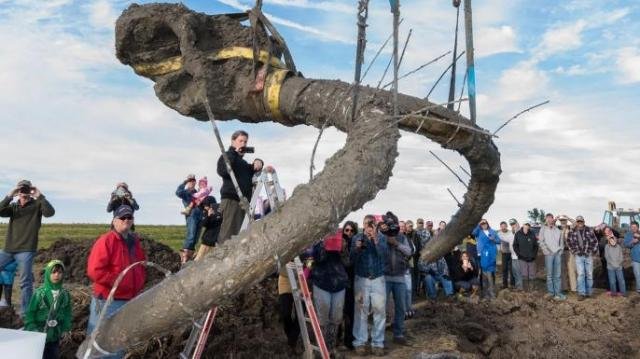In 2015, soybean farmer James Bristle made an astonishing discovery. On his farm just outside Chelsea, Michigan, he found an enormous rib bone. When paleontologists from the University of Michigan came to investigate, they found the skull and bones of an ancient, enormous mammoth.
Recently, the paleontologists returned to the site to see if they could uncover more bones. They found more from the same animal, as well as some surprising information suggesting that early humans had been there to eat it.

In 2015, a farmer found this mammoth on his farm in Michigan. In 2017, more bones told a new story to scientists. Daryl Marshke/University of Michigan
Trending: Terry Crews Slams National Enquirer's Dylan Howard After Sexual Misconduct Allegations
Daniel Fisher, a paleontologist at the University of Michigan, told Newsweek that while the information found in the bones has not been published in a peer-reviewed journal, he feels that the evidence for human intervention is strong.
Excavators found several mammoth bones at the bottom of what was once a pond, as well as three out-of-place boulders. Fisher suggested that primitive humans might have stored the meat at the bottom of the pond, intentionally placing boulders in the pond to anchor the body parts down. Fisher explained that, when you anchor animal parts in certain ponds, other animals have a hard time scavenging the material, and the bacteria in the pond will actually protect the remains from other, harmful bacteria. Fisher said he has tried this technique himself with meat from a variety of animals and never got sick from it. “It actually works much better than you might think,” he said.
Another important line of evidence is the way that the mammoth skull was cut up. Someone had accessed the pulp of the animal’s tusks and broken into the back of the skull in a way that only an intelligent butcher might. “This wasn’t the first time they’d taken apart these animals,” Fisher explained. “They didn’t just sort of wantonly bash it all up, they were interested in effective use of affected materials, as any other knowledgeable butcher would be.”
Don't miss: Internet Nazis May Be 'Better Funded in the Future,' New Report Warns
Furthermore, the marks on the skull suggest tool use. “The bone all around there has been basically broken loose—wack wack wack wack!—in a series of strikes,” Fisher explained.
This information could have an important impact on the understanding of anthropology, at least in Michigan. Previously, the oldest evidence for humans in the state dates to about 13,000 years ago, when the Clovis people were thought to be in the area and hunting with spears.
However, radiocarbon dating from the Michigan mammoth points to it being more than 15,000 years old. If humans were there to cut up and eat the animal, that would alter their historical timeline.
Paleontologists at the University of Michigan plan to study the bones in more detail to find out more about what happened to this mammoth, and to the people who may have been there.
This article was first written by Newsweek
More from Newsweek
Mystery Of How Early Man Hunted Mammoths Using Their Own Tusks Revealed
U.S. and Korea Search for Woolly Mammoth DNA in Arctic, in Race to Clone Extinct Beast
Ancient Bones 'Butchered' By Our Ancestors 2.5 Million Years Ago May Just Have Been Gnawed By Crocodiles
Hi! I am a robot. I just upvoted you! I found similar content that readers might be interested in:
http://www.newsweek.com/ancient-mammoth-bones-marked-human-butchering-found-michigan-735616